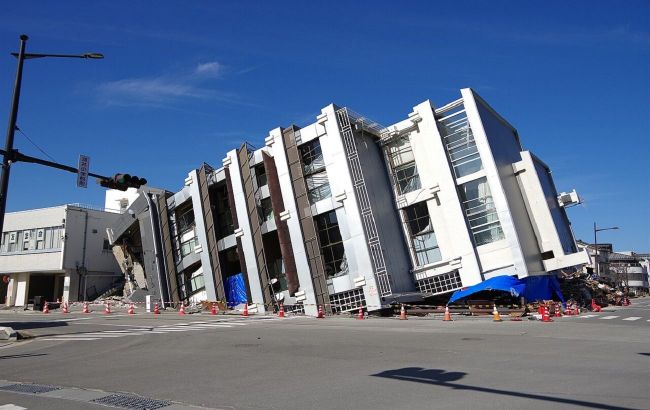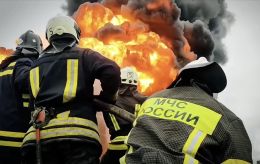5 most destructive earthquakes in human history
 A destroyed building after the 2024 earthquake in Japan (photo: Wikipedia)
A destroyed building after the 2024 earthquake in Japan (photo: Wikipedia)
Earthquakes are one of the most powerful natural disasters that can cause massive damage and claim thousands of lives. The history of mankind remembers numerous cases when earthquakes changed the course of events, destroyed cities and took lives.
Earthquake in Aleppo, 1138, Syria
On October 11, 1138, an earthquake of magnitude 8.5 struck the city of Aleppo, killing more than 230,000 people. The destruction covered the territories of modern northern Syria and southwestern Türkiye. This earthquake was one of the most destructive in the Middle Ages.
Most of the victims died due to the collapse of buildings and the inability to provide assistance due to damaged infrastructure. There are still traces of ancient settlements in the area where the earthquake occurred, testifying to the magnitude of the tragedy.
Today, these sites are being studied by archaeologists to understand how such natural disasters affected the development of medieval civilizations.
 Syria and Türkiye remain seismically hazardous areas to this day. Consequences of the earthquake in Syria in 2023 (photo: Wikipedia)
Syria and Türkiye remain seismically hazardous areas to this day. Consequences of the earthquake in Syria in 2023 (photo: Wikipedia)
The Great Chinese Earthquake, 1556, China
On January 23, 1556, an earthquake of magnitude 8.0 occurred in Shaanxi province, killing more than 830,000 people.
The epicenter was located in the Wei River Valley. Most of the victims were killed by the collapse of buildings, many of which were dug in soft soil that was subject to destruction. The destruction spread up to 500 km from the epicenter.
This earthquake is considered the deadliest in human history. Although China has since made significant strides in building its safety system, this earthquake has left a deep mark on people's memories.
 The 1556 earthquake was huge in area (photo: Wikipedia)
The 1556 earthquake was huge in area (photo: Wikipedia)
Calcutta earthquake, 1737, India
On October 12, 1737, an earthquake of magnitude 7.5 occurred in the city of Calcutta, which claimed about 300,000 lives. The destruction was widespread, many buildings collapsed, and the ground split, forming cracks and sinkholes. This earthquake was the deadliest in the history of India.
The earthquake resulted in numerous earthquake waves, which further complicated the situation for the victims. The city of Kolkata, which was an important commercial and administrative center at the time, did not fully recover from the disaster.
After this earthquake, India began to pay more attention to seismic activity and introduce measures to reduce risks. The disaster has become one of the biggest challenges for local residents, causing deep social and economic turmoil.
Tangshan earthquake, 1976, China
On July 28, 1976, a 7.8-magnitude earthquake hit the city of Tangshan, destroying 90% of the city's buildings. Officially, more than 242,000 people died, but according to unofficial data, up to 655,000.
The main impact occurred at night when most residents were sleeping. This earthquake was one of the most destructive in the 20th century.
It is noted that as a result of the disaster, Tangshan became a symbol of Chinese courage and resilience, as the reconstruction of the city began almost immediately after the tragedy. In addition, this earthquake emphasized the importance of predicting and monitoring seismic activity to prevent losses.
 Memorial to the victims of the Tangshan earthquake (photo: Wikipedia)
Memorial to the victims of the Tangshan earthquake (photo: Wikipedia)
Tohoku earthquake, 2011, Japan
On March 11, 2011, a magnitude 9.1 earthquake struck the Tohoku region, causing a powerful tsunami. More than 15,000 people died and more than 2,500 people were reported missing. This earthquake was one of the most powerful in the history of Japan.
The early warning system, which is one of the most developed in the world, helped to reduce the number of victims, but the destruction was widespread. The earthquake also triggered the Fukushima Nuclear Power Plant incident, which resulted in one of the worst nuclear disasters.
This earthquake has become a lesson for the entire planet on the importance of modernizing infrastructure and developing warning systems to minimize the consequences of such disasters.
.jpg) The destroyed building of the Fukushima nuclear power plant (photo: Wikipedia)
The destroyed building of the Fukushima nuclear power plant (photo: Wikipedia)
Read also about the history of 5 great cities of forgotten civilizations.
Sources: History, Live Science, Wikipedia.

